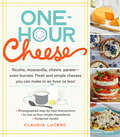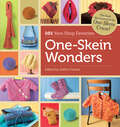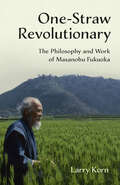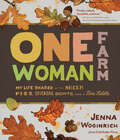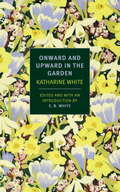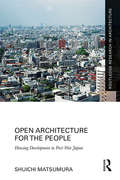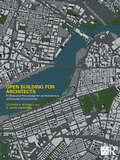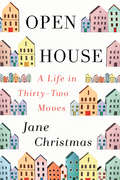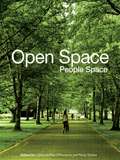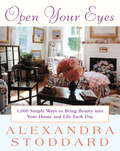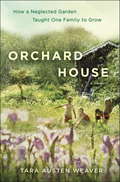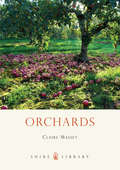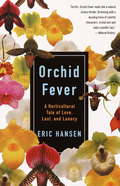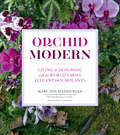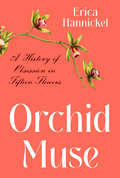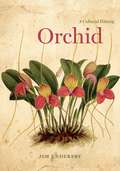- Table View
- List View
One Year to an Organized Life: A Week-by-Week Mindful Guide to Getting Organized for Good
by Regina LeedsA comprehensive, week-by-week bible to completely streamline all aspects of your life—now revised & updated for a global pandemic world of working from home and learning to de-stress while you de-clutter. Who would you be if you felt at peace and had more time and money? An organized life enables you to have more freedom, less aggravation, better health, and to get more done. Regina Leeds has helped even the messiest turn their lives around. One Year to an Organized Life is a unique week-by-week approach that you can begin at any time of year. Regina helps you break down tasks and build routines over time so that life becomes simple, not overwhelming. Whether you're living in chaos or just looking for new ways to simplify, this essential book will help you get the whole household organized-and stay that way. Covid has shaken humanity to the core and forced us to slow down and reimagine the way we use our living spaces. In a flash, the space we knew simply as home was suddenly a classroom, our office and the gym. And, at a time when stress and anxiety is at an all-time high, it no longer seems odd to meditate. It feels life-saving. If life is to be re-imagined, shouldn&’t we also do that with our living spaces? In this revised and updated edition of One Year to an Organized Life, Regina Leeds reveals how to optimize your space—for work, family and daily calmness (with plenty of new affirmations and reward systems built into her organizing tips).
One Year to an Organized Life: From Your Closets to Your Finances, the Week-by-Week Guide to Getting Completely Organized for Good
by Regina LeedsWho would you be if you felt at peace and had more time and money? An organized life enables you to have more freedom, less aggravation, better health, and to get more done. For nearly twenty years, Regina Leeds-named Best Organizer by Los Angeles magazine-has helped even the messiest turn their lives around. Anyone can get organized-she’ll prove it to you! One Year to an Organized Life is a unique week-by-week approach that you can begin at any time of year. Regina helps you break down tasks and build routines over time so that life becomes simple, not overwhelming. Master time management Make your kitchen efficient Permanently organize closets and drawers Deal with your finances Reclaim "dumping grounds” like the guest room, garage and basement Declutter the kids’ rooms Organize your travel plans-and the vacation photos and souvenirs Entertain with joy Regina reveals her magic formula for organizing anything, plus her method to stop the chronic cycles of clutter, misplaced items, and lateness. Whether you’re living in chaos or just looking for new ways to simplify, this essential book will help you get the whole household organized-and stay that way.
One-Hour Cheese: Ricotta, Mozzarella, Chèvre, Paneer--Even Burrata. Fresh and Simple Cheeses You Can Make in an Hour or Less!
by Claudia LuceroIt’s a DIY cook’s dream come true: It’s pizza night, and you’ve made not only the crust and sauce but the mozzarella, too. Or you're whipping up quesadillas for a snack, using your homemade Triple Pepper Hack. Or the dinner party's in high gear and out comes the cheese plate—and yes, you've made all the cheeses on it. Even better—you made them all earlier that day. In a cookbook whose results seem like magic but whose recipes and instructions are specific, easy-to-follow, and foolproof, Claudia Lucero shows step by step—with every step photographed—exactly how to make sixteen fresh cheeses at home, using easily available ingredients and tools, in an hour or less. The approach is basic and based on thousands of years of cheesemaking wisdom: Heat milk, add coagulant, drain, salt, and press. Simple variations produce delicious results across three categories—Creamy and Spreadable, Firm and Chewy, and Melty and Gooey. And just as delicious, the author shows the best ways to serve them, recipes included: Squeaky “Pasta” Primavera, Mozzarella Kebab Party, and Curry in a Hurry Lettuce Wraps.
One-Skein Wonders®: 101 Yarn-shop Favorites (One-Skein Wonders)
by Judith DurantIf you’re like most knitters, you have lonely skeins of yarn in your closet — casualties of projects discarded mid-row or leftovers from long-completed pieces. Offering 101 charming designs that use just a single skein of yarn, Judith Durant shows you how to turn these extra bits of fiber into stylish hats, mittens, scarves, and tea cozies. Covering a wide range of tastes and styles, this collection will inspire you to dig out your orphan yarn and get stitching.
One-Straw Revolutionary: The Philosophy and Work of Masanobu Fukuoka
by Larry KornOne-Straw Revolutionary represents the first commentary on the work of the late Japanese farmer and philosopher Masanobu Fukuoka (1913 – 2008), widely considered to be natural farming&’s most influential practitioner.Mr. Fukuoka is perhaps most known for his bestselling book The One-Straw Revolution (1978), a manifesto on the importance of no-till agriculture, which was at the time of publication a radical challenge to the global systems that supply the world&’s food, and still inspires readers today. Larry Korn, who apprenticed with Mr. Fukuoka in Japan at the time, translated the manuscript and brought it to the United States, knowing it would change the conversation about food forever. The One-Straw Revolution, edited by Korn and Wendell Berry, was an immediate international success, and established Mr. Fukuoka as a leading voice in the fight against conventional industrial agriculture. In this new book, through his own personal narrative, Larry Korn distills his experience of more than thirty-five years of study with Mr. Fukuoka, living and working on his farm on Shikoku Island, and traveling with Mr. Fukuoka to the United States on two six-week visits. One-Straw Revolutionary is the first book to look deeply at natural farming and intimately discuss the philosophy and work of Mr. Fukuoka. In addition to giving his personal thoughts about natural farming, Korn broadens the discussion by pointing out natural farming&’s kinship with the ways of indigenous cultures and traditional Japanese farming. At the same time, he clearly distinguishes natural farming from other forms of agriculture, including scientific and organic agriculture and permaculture. Korn also clarifies commonly held misconceptions about natural farming in ways Western readers can readily understand. And he explains how natural farming can be used practically in areas other than agriculture, including personal growth and development.The book follows the author on his travels from one back-to-the-land commune to another in the countryside of 1970s Japan, a journey that eventually led him to Mr. Fukuoka&’s natural farm. Korn&’s description of his time there, as well as traveling with Mr. Fukuoka during his visits to the United States, offers a rare, inside look at Mr. Fukuoka&’s life. Readers will delight in this personal insight into one of the world&’s leading agricultural thinkers.&“A profound sharing of the essential philosophy of natural farming translated through the friendship between Larry Korn and Masanobu Fukuoka. . . [It] offers wise insights into authentic practices that honor the community of all life.&”—Katrina Blair, author of The Wild Wisdom of Weeds
One-Woman Farm: My Life Shared with Sheep, Pigs, Chickens, Goats, and a Fine Fiddle
by Jenna WoginrichIn this inspiring memoir, Jenna Woginrich reflects on the joys, sorrows, trials, and blessings discovered through a year of homesteading. With eloquent prose, delightful illustrations, and inspiring snippets of poetry, Woginrich revels in the unique charms of each season on the land. Full of poignant observations and fascinating tidbits of farming lore, this book is a heartfelt testament to the deep fulfillment one can find in the practical tasks and timeless rituals of an agricultural life.
One-Yard Wonders: 101 Sewing Fabric Projects; Look How Much You Can Make with Just One Yard of Fabric! (One-Yard Wonders)
by Patricia Hoskins Rebecca YakerDiscover all that you can make with just one yard of fabric! Rebecca Yaker and Patricia Hoskins offer 101 fun projects that use a single yard of fabric to make clothes, accessories, baby items, and more. With clear, step-by-step instructions, each project is designed to be completed in just a few hours. Get inspired and turn a yard of your favorite fabric into a quilted lunch bag, bright sundress, or a cuddly plush turtle.
Onward and Upward in the Garden
by E. B. White Katherine S. WhiteIn 1925 Harold Ross hired Katharine Sergeant Angell as a manuscript reader for The New Yorker. Within months she became the magazine's first fiction editor, discovering and championing the work of Vladimir Nabokov, John Updike, James Thurber, Marianne Moore, and her husband-to-be, E. B. White, among others. After years of cultivating fiction, White set her sights on a new genre: garden writing. On March 1, 1958, The New Yorker ran a column entitled "Onward and Upward in the Garden," a critical review of garden catalogs, in which White extolled the writings of "seedmen and nurserymen," those unsung authors who produced her "favorite reading matter." Thirteen more columns followed, exploring the history and literature of gardens, flower arranging, herbalists, and developments in gardening. Two years after her death in 1977, E. B. White collected and published the series, with a fond introduction. The result is this sharp-eyed appreciation of the green world of growing things, of the aesthetic pleasures of gardens and garden writing, and of the dreams that gardens inspire.
Onward and Upward in the Garden
by Katharine S. WhiteMrs. White loved gardens and spent much time working in hers and writing about all things related. Her husband's introduction to this book is warm and informative.
Open Architecture for the People: Housing Development in Post-War Japan (Routledge Research in Architecture)
by Shuichi MatsumuraOpen Architecture for the People explores Japanese architecture and the three different phases of development between the years 1950 and 2018. Changing ways of life through differing generations have caused fluctuations in the building industry. This book demonstrates how each generation's expectations have resulted in discernible eras in architecture which can be examined collectively as well as in isolation. For example, the sudden increase in productivity from 1950 brought about by the Industrial Revolution flowed to the production of buildings and homes and designs were influenced by modern ideas. With over thirty black and white images to illustrate the changes, Matsumura brings to light architectural developments that have previously been confined to Japanese speaking academics. In doing so, the book broadens the scope for further architectural examinations internationally. It would be ideal for academics, students and professionals within the areas of architecture and urban planning, particularly those with an interest in Japanese architecture.
Open Building for Architects: Professional Knowledge for an Architecture of Everyday Environment (Open Building)
by N. John Habraken Stephen H. KendallOpen Building is an internationally recognized approach to the design of buildings and building complexes with roots in the way the ordinary built environment grows and regenerates. The Open Building approach recognizes that both stability and change are realities to be managed in the contemporary built environment. Buildings – and the neighborhoods they occupy – are not static during the most stable times or during times of rapid social and technical change. They are living organisms that need constant adjustments to remain attractive, safe and valuable.Using case studies of built projects from around the world, this book explains the Open Building approach and discusses important characteristics of everyday built environment that the Open Building approach designs for. It also presents a key method that can be used to put the approach into use. It addresses questions such as: How can we design large projects for inevitable change? How can we balance the demands of large projects for efficient implementation with the need for ‘fine-grained’ decision-making control? How can we separate design tasks, one task being the design of what should last a century, the other task being the design of more mutable units of occupancy? How can we identify and share architectural themes and, at the same time, make variations on them? How can we use the Open Building approach to steward the earth’s scarce resources and contribute to a circular economy that benefits all people? This book is an essential resource for practitioners, investors and developers, regulators, builders, product manufacturers and educators interested in why the Open Building approach matters and how to practice Open Building.
Open Concept Houses
by Francesc ZamoraFrom the author of the successful 150 Best series comes the debut entry in the forward-thinking Open Concept Houses series, filled with nearly 500 pages of color photos—sure to become the ultimate resource for this fast-growing trend in home design and renovation.One of the hottest lifestyle trends today, open concept living spaces eliminate doorways and walls to create a large combined area for cooking, dining, entertaining, and relaxing. No longer are the kitchen, dining room, and living room compartmentalized. Instead, each space blends into the next to create one large area "separated" and defined by islands, carpets, and furniture. This increasingly popular style provides a sense of expansiveness, connectedness, and flow that traditional architecture and design—defined by spaces broken by walls—lack.This engaging, inspiring, and informative volume brings together a diverse collection of houses from all over the world, including spaces that have been designed from the ground up or have been renovated to reflect this popular trend. Inside Open Concept Houses you’ll find an array of beautiful and creative homes by distinguished international architects and designers who have conceived practical and functional solutions adapted to the specific needs and particular tastes of their clients.Filled with hundreds of full-color photographs as well as sets of floorplans for renovated residences—both the original and remodeled blueprints—this imaginative, idea-filled book is a must-have for architects, designers, decorators, and home owners looking to create or adapt the open concept style in their own dwellings.
Open House: A Life in 32 Moves
by Jane ChristmasMoving house has never flustered author Jane Christmas. She loves houses: viewing them, negotiating their price, dreaming up interior plans, hiring tradespeople to do the work and overseeing renovations. She loves houses so much that she’s moved thirty-two times.There are good reasons for her latest house move, but after viewing sixty homes, Jane and her husband succumb to the emotional fatigue of an overheated English housing market and buy a wreck in the town of Bristol that is overpriced, will require more money to renovate than they have and that neither of them particularly like.As Jane’s nightmare renovation begins, her mind returns to the Canadian homes where she grew up with parents who moved and renovated constantly around the Toronto area. Suddenly, the protective seal is blown off Jane’s memory of a strict and peripatetic childhood and its ancillary damage—lost friends, divorces, suicide attempts—and the past threatens to shake the foundations of her marriage. This latest renovation dredges a deeper current of memory, causing Jane to question whether in renovating a house she is in fact attempting to renovate her past.With humour and irreverence, Open House reveals that what we think we gain by constantly moving house actually obscures the precious and vital parts of our lives that we leave behind. This is a memoir that will appeal to anyone whose pulse quickens at the mere mention of real estate.
Open Space: Open Space: People Space 2
by Catharine Ward Thompson Penny TravlouHighly visual and containing contributions from leading names in landscape, architecture and design, this volume provides a rare insight into people’s engagement with the outdoor environment; looking at the ways in which the design of spaces and places meets people’s needs and desires in the twenty-first century. Embracing issues of social inclusion, recreation, and environmental quality, the editors explore innovative ways to develop an understanding of how the landscape, urban or rural, can contribute to health and quality of life. Open Space: People Space examines the nature and value of people’s access to outdoor environments. Led by Edinburgh’s OPENspace research centre, the debate focuses on current research to support good design for open space and brings expertise from a range of disciplines to look at: an analysis of policy and planning issues and challenges understanding the nature and experience of exclusion the development of evidence-based inclusive design innovative research approaches which focus on people’s access to open space and the implications of that experience. Invaluable to policy makers, researchers, urban designers, landscape architects, planners, managers and students, it is also essential reading for those working in child development, health care and community development.
Open Your Eyes
by Alexandra StoddardFor nearly forty years and in numerous books, Alexandra Stoddard has shared her keen eye for design and sure sense of style. Now this renowned decorator and lifestyle philosopher teaches you hoe to see with the expertise and clarity of professional designers. First, Alexandra helps you become more attuned to your surroundings-as you set a table, straighten out a linen closet, stroll through a garden, or browse in a thrift shop. Then, through personal anecdotes; examples from masters; a rich array of ideas, tips, and techniques, she reveals hundreds of ways to see and solve problems or proportion, pattern, color, and composition. Her simple suggestions-whether it's changing a lampshade, rearranging treasured objects on a table, or moving a chair-will yield dramatic results. Filled with practical solutions offered with warmth and encouragement , Open Your Eyes helps make each day a visual feats as it deepens your understanding not only of what makes something beautiful but what makes something beautiful to you.
Opium for the Masses
by Jim Hogshire"Contrary to general belief, there is no federal law against growing P. somniferum."--Martha Stewart Living"Regarded as 'God's own medicine,' preparations of opium were as common in the Victorian medicine cabinet as aspirin is in ours. As late as 1915, pamphlets issued by the U.S. Department of Agriculture were still mentioning opium poppies as a good cash crop for northern farmers. Well into this century, Russian, Greek, and Arab immigrants in America have used poppy-head tea as a mild sedative and a remedy for headaches, muscle pain, cough, and diarrhea. During the Civil War, gardeners in the South were encouraged to plant opium for the war effort, in order to ensure a supply of painkillers for the Confederate Army. What Hogshire has done is to excavate this vernacular knowledge and then publish it to the world--in how-to form, with recipes."-- Michael PollanFirst published fifteen years ago, Opium for the Masses instantly became a national phenomenon. Michael Pollan wrote a lengthy feature ("Opium, made easy") about Jim Hogshire in Harper's Magazine, amazed that the common plant, P. somniferum, or opium poppies, which grows wild in many states and is available at crafts and hobby stores and nurseries, could also be made into a drinkable tea that acts in a way similar to codeine or Vicodin.With Opium for the Masses as their guide, Americans can learn how to supplement their own medicine chest with natural and legal pain medicine, without costly and difficult trips to the doctor and pharmacy.
Optoelectronic Organic-Inorganic Semiconductor Heterojunctions
by Ye ZhouOptoelectronic Organic-Inorganic Semiconductor Heterojunctions summarizes advances in the development of organic-inorganic semiconductor heterojunctions, points out challenges and possible solutions for material/device design, and evaluates prospects for commercial applications. Introduces the concept and basic mechanism of semiconductor heterojunctions Describes a series of organic-inorganic semiconductor heterojunctions with desirable electrical and optical properties for optoelectronic devices Discusses typical devices such as solar cells, photo-detectors, and optoelectronic memories Outlines the materials and device challenges as well as possible strategies to promote the commercial translation of semiconductor heterojunctions-based optoelectronic devices Aimed at graduate students and researchers working in solid-state materials and electronics, this book offers a comprehensive yet accessible view of the state of the art and future directions.
Oranges For Orange Juice (Social Studies Learn To Read)
by Craig Brown Rozanne WilliamsRepetitive, predictable story lines and illustrations that match the text provide maximum support to the emergent reader. Engaging stories promote reading comprehension, and easy and fun activities on the inside back covers extend learning. Great for Reading First, Fluency, Vocabulary, Text Comprehension, and ESL/ELL!
Orchard House
by Tara Austen WeaverFor fans of Anne Lamott, a profoundly moving memoir of rediscovering, reinventing, and reconnecting, as an estranged mother and daughter come together to revive a long-abandoned garden and ultimately their relationship and themselves. Peeling paint, stained floors, vined-over windows, a neglected and wild garden--Tara Austen Weaver can't get the Seattle real estate listing out of her head. Any sane person would have seen the abandoned property for what it was: a ramshackle half-acre filled with dead grass, blackberry vines, and trouble. But Tara sees potential and promise--not only for the edible bounty the garden could yield for her family, but for the personal renewal she and her mother might reap along the way. So begins Orchard House, a story of rehabilitation and cultivation--of land and soul. Through bleak winters, springs that sputter with rain and cold, golden days of summer, and autumns full of apples, pears, and pumpkins, this evocative memoir recounts the Weavers' trials and triumphs, detailing what grew and what didn't, the obstacles overcome and the lessons learned. Inexorably, as mother and daughter tend this wild patch and the fruits of their labor begin to flourish, green shoots of hope emerge from the darkness of their past. For everyone who has ever planted something that they wished would survive--or tried to mend something that seemed forever broken--Orchard House is a tale of healing and growth set in a most unlikely place.Praise for Orchard House "This touching memoir chronicles how the act of transforming a garden together--of 'planting hope'--helps a mother and daughter reconnect and revive the sense of groundedness that had been lost within their relationship and themselves. . . . [Orchard House] deftly [captures] the love, laughter, trials and tears that make motherhood the joy and job it truly is."--American Way "Honest and moving . . . [the story of] one woman's initiation into intensive gardening with her mother, which changed a neglected space into something beautiful and bountiful and shifted their relationship as well."--Kirkus Reviews "Fascinating, tender, often heartbreaking . . . The perfect gift for a mother or a daughter with an appreciation for the transformative power of gardening."--HGTV Gardens "A wise exploration of family roots . . . Nurturing a garden is a lovely metaphor for healing a family. . . . [Orchard House] could serve as a handbook for both."--Shelf Awareness "With buoyant grace and empathic insights, Weaver offers an ardent tribute to both the science of perseverance and the art of letting go."--Booklist"This is a glorious book--lyrical, honest, compassionate, and wise. It reminds us that gardens and families are messy businesses, but from them we can harvest hope and food and moments of grace."--Erica Bauermeister, author of The School of Essential Ingredients "Filled with sensuous descriptions, this beguiling story enchants. Gardeners and non-gardeners alike will delight in this lyrical tale of how a garden grows a family."--Diana Abu-Jaber, author of The Language of Baklava and Birds of Paradise"Orchard House is a glorious and deeply moving story of one family's redemption. If Anne Lamott and Wendell Berry ever had a literary love child, Tara Austen Weaver might well be her."--Elissa Altman, author of Poor Man's FeastFrom the Hardcover edition.
Orchards
by Claire MassetWhether in blossom and laden with fruit, orchards are places of great beauty. Throughout history, they have played an important role in country, and also city, life, providing not just food and drink, but also a haven for wildlife and a setting for age-old customs and social gatherings. Some of Britain's surviving orchards are almost 600 years old. But when did orchards first appear? Why are there over 3,000 varieties of apple, so varied in colour, shape, texture and taste? What is wassailing and who did it? Why has England lost almost two-thirds of its orchards since 1950 - and what is being done about it today? This beautifully illustrated book reveals the engaging story and rich diversity of Britain's orchards and answers many intriguing questions along the way.
Orchid Fever: A Horticultural Tale of Love, Lust, and Lunacy
by Eric HansenThe acclaimed author of Motoring with Mohammed brings us a compelling adventure into the remarkable world of the orchid and the impossibly bizarre array of international characters who dedicte their lives to it.The orchid is used for everything from medicine for elephants to an aphrodisiac ice cream. A Malaysian species can grow to weigh half a ton while a South American species fires miniature pollen darts at nectar-sucking bees. But the orchid is also the center of an illicit international business: one grower in Santa Barbara tends his plants while toting an Uzi, and a former collector has been in hiding for seven years after serving a jail sentence for smuggling thirty dollars worth of orchids into Britain. Deftly written and captivatingly researched, Orchid Fever is an endlessly enchanting and entertaining tour of an exotic world."A wonderful book, I've been up all night reading it, laughing and crying out in horror and clucking at the vivid images of bureaucracy with the bit in its teeth." --Annie Proulx"An extraordinary, well-told tale of botany, obsession and plant politics. Hansen's vivid descriptions of the complex techniques some orchids use to pollinate themselves will raise your eyebrows at nature's sexual ingenuity." --USA Today
Orchid Growing for Wimps
by Ellen ZachosA superb primer on orchid culture. It uses a step-by-step approach and doesn't skimp on relating complete details. There's a chapter showing easy-to-grow orchids in all their glory, and there's also a chapter warning about 'difficult' orchids to avoid. This book takes you on a visit to 16 terrific varieties you can easily handle.
Orchid Modern: Living and Designing with the World's Most Elegant Houseplants
by Marc Hachadourian“This beautiful book is useful for all of us, novice and experienced orchid lovers alike.” —Martha Stewart, author, entrepreneur, founder of Martha Stewart Living Omnimedia Add the vibrant colors and exotic blooms of orchids to your houseplant haven! It’s easier than you think with the help of Orchid Modern. Marc Hachadourian, the curator of the orchid collection at the New York Botanical Garden, shares his secrets to successfully growing these sometimes finicky houseplants. Besides the basics, you’ll learn his top 120 orchid picks for green and not-so-green thumbs. Ten inspirational, step-by-step projects, including terrariums, a wreath, and a kokedama, provide the confidence to make orchids a thriving, vivid part of your home’s signature style.
Orchid Muse: A History Of Obsession In Fifteen Flowers
by Erica HannickelOne of Literary Hub's Most Anticipated Books of 2022 A kaleidoscopic journey into the world of nature’s most tantalizing flower, and the lives it has inspired. The epitome of floral beauty, orchids have long fostered works of art, tales of adventure, and scientific discovery. Tenacious plant hunters have traversed continents to collect rare specimens; naturalists and shoguns have marveled at orchids’ seductive architecture; royalty and the smart set have adorned themselves with their allure. In Orchid Muse, historian and home grower Erica Hannickel gathers these bold tales of the orchid-smitten throughout history, while providing tips on cultivating the extraordinary flowers she features. Consider Empress Eugenie and Queen Victoria, the two most powerful women in nineteenth-century Europe, who shared a passion for Coelogyne cristata, with its cascading, fragrant white blooms. John Roebling, builder of the Brooklyn Bridge, cultivated thousands of orchids and introduced captivating hybrids. Edmond Albius, an enslaved youth on an island off the coast of Madagascar, was the first person to hand-pollinate Vanilla planifolia, leading to vanilla’s global boom. Artist Frida Kahlo was drawn to the lavender petals of Cattleya gigas and immortalized the flower’s wilting form in a harrowing self-portrait, while more recently Margaret Mee painted the orchids she discovered in the Amazon to advocate for their conservation. The story of orchidomania is one that spans the globe, transporting readers from the glories of the palace gardens of Chinese Empress Cixi to a seedy dime museum in Gilded Age New York’s Tenderloin, from hazardous jungles to the greenhouses and bookshelves of Victorian collectors. Lush and inviting, with radiant full-color illustrations throughout, Orchid Muse is the ultimate celebration of our enduring fascination with these beguiling flowers.
Orchid: A Cultural History
by Jim EndersbyAt once delicate, exotic, and elegant, orchids are beloved for their singular, instantly recognizable beauty. Found in nearly every climate, the many species of orchid have carried symbolic weight in countless cultures over time. The ancient Greeks associated them with fertility and thought that parents who ingested orchid root tubers could control the sex of their child. During the Victorian era, orchids became deeply associated with romance and seduction. And in twentieth-century hard-boiled detective stories, they transformed into symbols of decadence, secrecy, and cunning. What is it about the orchid that has enthralled the imagination for so many centuries? And why do they still provoke so much wonder? Following the stories of orchids throughout history, Jim Endersby divides our attraction to them into four key themes: science, empire, sex, and death. When it comes to empire, for instance, orchids are a prime example of the exotic riches sought by Europeans as they shaped their plans for colonization. He also reveals how Charles Darwin's theory of evolution became intimately entangled with the story of the orchid as he investigated their methods of cross-pollination. As he shows, orchids--perhaps because of their extraordinarily diverse colors, shapes, and sizes--have also bloomed repeatedly in films, novels, plays, and poems, from Shakespeare to science fiction, from thrillers to elaborate modernist novels. Featuring many gorgeous illustrations from the collection of the Royal Botanic Gardens, Kew, Orchid: A Cultural History tells, for the first time, the extraordinary story of orchids and our prolific interest in them. It is an enchanting tale not only for gardeners and plant collectors, but anyone curious about the flower's obsessive hold on the imagination in history, cinema, literature, and more.


